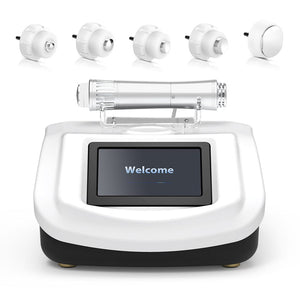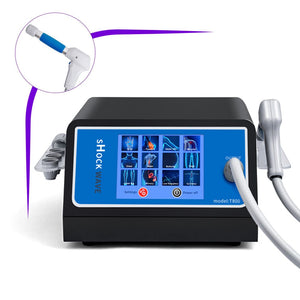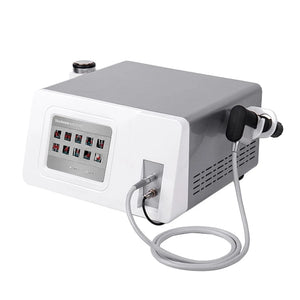Chronic pain or osteoarthritis can limit your mobility and enjoyment of life. You may have tried medication or physical therapy, but the ache does not go away. If traditional treatments have not brought relief, shockwave therapy may come to your aid.
This blog will discuss everything about shockwave therapy machines (or ESWT Machines). We will explore how they work, the benefits they offer, and how to choose the right device for your needs. So, if you want to give shockwave therapy a shot, keep reading!
What is a Shockwave Therapy Machine?
A shockwave therapy machine is also known as Extracorporeal shockwave therapy (ESWT). It is a device that uses acoustic waves to deliver pulsed, high-energy sound waves to targeted areas of the body. These waves are to stimulate healing, regeneration, and pain relief in soft tissues. This can be particularly helpful for conditions like myofascial release syndrome, a common cause of chronic pain and stiffness.
Shockwave therapy is a non-invasive treatment that you can consider as an alternative treatment for a variety of conditions, including:
- Chronic tendinitis
- Plantar fasciitis
- Tennis elbow
- Trigger points
- Myofascial pain syndrome
- Erectile dysfunction treatment
- Slow-healing wounds
There are two main types of shockwave therapy machines: radial and focused.
- Radial shock wave therapy machines deliver waves that spread out in a cone-shaped pattern. This type of therapy is used to treat larger areas of tissue.
- Focused shockwave therapy machines deliver waves that are concentrated on a small point. This type of therapy is used to treat deeper tissues.
Shockwave therapy is typically performed in a doctor's office or outpatient clinic. It can also be used as a home therapy. The treatment is usually well-tolerated, with minimal side effects. If you are considering shockwave therapy, it is important to talk to your doctor to see if it is right for you.
3 Benefits of Using a Shockwave Therapy Machine
Shockwave therapy machines are becoming increasingly popular for treating chronic pain and promoting healing in various painful soft tissue conditions, aiding in rehabilitation. If you are considering purchasing a shockwave therapy machine for sale, here are three key benefits to consider:
1. Non-invasive Treatment for Chronic Pain:
Unlike surgery or injections, shockwave therapy is a non-invasive therapy. This means no needles, no cuts, and minimal downtime for recovery. The machine delivers high-energy acoustic waves to the targeted area. It helps to stimulate blood flow, reduce inflammation, and promote tissue repair. This translates to noticeable pain relief for conditions like chronic tendinitis, plantar fasciitis, and tennis elbow.
2. Faster Healing and Improved Mobility:
Shockwave therapy not only addresses pain; it can also accelerate the healing process. The acoustic waves encourage the growth of new blood vessels, which improves the delivery of oxygen and nutrients to the injured area after sports injuries. This can significantly reduce healing times and get you back to your daily activities faster. Plus, by breaking down scar tissue and promoting tissue regeneration, shockwave therapy can improve your mobility and range of motion.
3. Long-Term Effects and Reduced Need for Medications:
Studies have shown that the effects of shockwave therapy can be long-lasting. It provides pain relief for months after the treatment cycle is complete. This can significantly reduce your reliance on pain medication, leading to fewer side effects and a more natural approach to managing chronic pain conditions.
Shockwave therapy is not a one-size-fits-all solution. Consulting with a healthcare professional is crucial to determine if it is the right treatment for your specific condition. They can also advise you on the appropriate settings if you want to address your cellulite reduction concerns.
How to Choose the Right Shockwave Therapy Machine
Professional shockwave therapy machines offer a promising approach to managing chronic pain and promoting healing. But with various options available, selecting the right shockwave therapy device can feel overwhelming. Here are a few points you may want to consider:
1. Focused vs. Radial Technology:
- Focused Therapy: This type of device delivers targeted, high-intensity waves to deeper tissue layers. It is ideal for treating specific trigger points and deeper chronic pain.
- Radial Therapy: These devices emit broader waves that treat larger areas of tissue. They are a good option for general pain management and conditions affecting superficial tissues.
2. Treatment Applications and Versatility:
Consider the range of conditions you plan to address with the device. Some shockwave therapy equipment offers various applicator heads to target different body parts and depths. If you have a specific chronic pain issue, and looking for a self-treatment therapy, look for a device with a suitable applicator.
3. Energy Levels and Adjustability:
Shockwave therapy involves calibrated energy levels for optimal results. Ensure the device offers adjustable settings to customize treatment intensity based on your pain tolerance and the targeted condition.
4. Treatment Protocols and User Interface:
- Treatment Protocols: Look for devices with pre-programmed settings for common conditions. This can be helpful, especially if you are new to shockwave therapy.
- User Interface: Choose a device with a clear and easy-to-use interface that allows you to adjust settings, monitor treatment progress, and ensure safe operation.
5. Safety and Certifications:
Opt for a device from a reputable manufacturer known for quality and reliability. Look for warranties and customer support options.
6. Portability and Ease of Use:
Consider how and where you plan to use the device. Portable models offer more flexibility for home use, while larger devices might be better suited for clinical settings. Evaluate the weight, size, and ease of operation of the device.
7. Budget:
Shockwave therapy machines may come with hefty price tags. Factor in the initial purchase cost, any ongoing maintenance requirements, and the availability of replacement parts.
Consulting with a healthcare professional is vital before purchasing a shockwave therapy machine. They can assess your specific needs, recommend suitable devices, and guide you on safe and effective applications.
By carefully considering these factors, you can make an informed decision and choose the right shockwave therapy device.
Frequently Asked Questions or FAQs
1. Is shockwave therapy painful?
Shockwave therapy might sound intense, but most patients experience discomfort, not sharp pain, during treatment. The feeling can vary depending on the individual's pain tolerance and the treated area. Some clinics may use a topical numbing cream to further reduce discomfort.
2. What are the potential side effects of shockwave therapy?
The good news is that shockwave therapy is generally well-tolerated with minimal side effects. You might experience some temporary soreness or bruising in the treated area, similar to a light workout. These side effects typically subside within a few days. If you experience any concerning side effects, like excessive pain, numbness, or bleeding, be sure to talk to your healthcare professional right away.
3. Who can benefit from shockwave therapy?
Shockwave therapy can be a helpful option for individuals struggling with tendonitis and pain in ligaments. It is also helpful in faster muscle recovery. Some common conditions that respond well to shockwave therapy include plantar fasciitis, tennis elbow, and chronic tendinitis. Consult with a healthcare professional to determine if shockwave therapy is the right course of treatment for your specific condition.
4. How long do the effects of shockwave therapy last?
The effects of shockwave therapy can be long-lasting, providing pain relief for months following the treatment cycle. Studies have shown positive results that can extend up to a year in some cases.
5. What should I expect during a shockwave therapy session?
A typical shockwave therapy session involves a technician applying a lubricating gel to the targeted area. The technician will then use the shockwave therapy machine to deliver sound waves to the treatment zone for several minutes. The settings on the device will be adjusted based on your specific condition and pain tolerance. The entire session is usually performed in an outpatient clinic setting and takes around 15-20 minutes.
DISCLAIMER
Last updated May 31, 2022
The information provided by myChway Online does not contain any medical claims and is not intended to diagnose or treat any disease. Any reference to medical treatment or health benefits should not be considered medical advice or a substitute for prescription drugs, nor should it be a diagnosis of a specific disease. No representations or warranties, express or implied, are made as to the effectiveness of the products. All products are for external use only.




